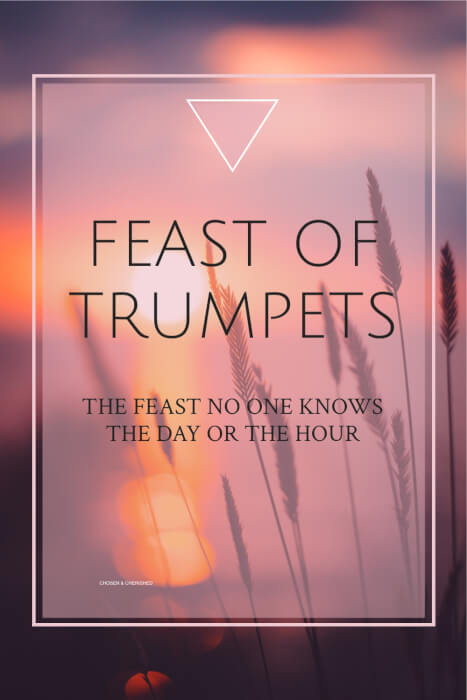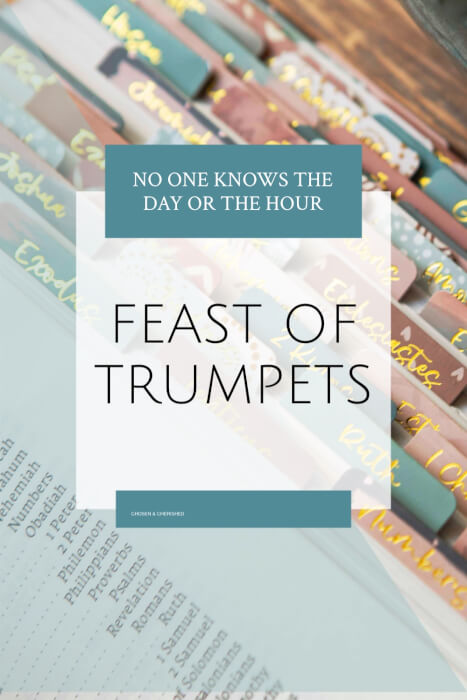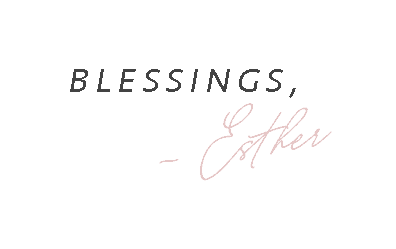“And He will send his angels with a loud trumpet call, and they will gather his elect from the four winds, from one end of the heavens to the other.” Matthew 24:31
Rosh Hashanah. Perhaps you’ve seen it on your trusty iPhone calendar or heard the term along the way. But what is Rosh Hashanah, and what does it have to do with Christians? If you’ve read the post on the Significance of the Biblical Feast (or downloaded the free workbook), you know there are two sets of feasts: spring and fall. While separated by season, they all find their fulfillment in Jesus (Colossians 2:17).
The spring feasts, occurring in the first and third month of the Jewish calendar, were fulfilled in the first advent of Christ. Jesus was tried and crucified on Passover, raised on Firstfruits, and the Holy Spirit was poured out on the Church during the Feast of Weeks or Pentecost (here’s a complete timeline of Holy Week). Considering the exact fulfillment of the spring feasts, we now jump into the fall feasts and the connection to Christ’s second coming. These fall feasts occurred in the seventh month, Tishri, regarded as the holiest month of the Jewish calendar. One key thing to remember is that Jesus was a Jew who abided by the Jewish feasts.
But why the seventh month?
- God created the world in six days and rested on the seventh.
- A Sabbath day of rest every seven days is the 4th command.
- There are seven holy feasts.
- Several feasts were seven days (Passover, Feast of Weeks, and Feast of Tabernacles).
- Every seven years was a Sabbath year of rest for the land.
- Every seven times seven years was Jubilee, a year of liberty.
- The holiest holiday (Day of Atonement) is in the seventh month.
- The walls of Jericho fell on the seventh day with seven trumpets blown by seven priests after having marched around the city seven times.
- There are seven churches in Revelation.
- Seven-year tribulation.
- There are seven seals, trumpets, and bowls of judgment in Revelation.
- The seventh angel of Revelation 11 blows his trumpet, announcing the eternal reign of King Jesus.
By occuring in the seventh month, there is a picture of perfect completion resulting in rest.

What is the Feast of Trumpets?
What became known as Rosh Hashanah (Head of the Year) began as Yom Teruah or the “Day of Trumpets.” According to Numbers 10:1-10, trumpets were blown on the first day of every month, at appointed feasts, going into battle, and summoning the congregation. But, on the first day (new moon) of this holiest month (seventh month, Tishri), these trumpet blasts were an extra special reminder of the approaching Day of Atonement (Leviticus 23:26–32). According to Jewish historians, trumpets sounded thirty consecutive times. Referenced in (Leviticus 23:23–25; Numbers 29:1–6). During this festival, trumpets announced a sacred assembly of celebration. People gathered to hear a public reading of the Law, offer special sacrifices to God, and rest from ordinary occupational work. Furthermore, this signaled the end of the agricultural year and the beginning of a new agricultural year.
When is the Feast of Trumpets? No one knows the day or hour.
The first day of this holy month began at sunset when two appointed witnesses confirmed the first sliver of a new moon. Due to the uncertainty of the weather, witnesses, and Sabbath, the Feast of Trumpets took place over two days. At this unknown day and hour, the shofar (ram’s horn) was blown, signaling the coming Days of Awe and the holiest day–Yom Kippur. Thus, the Feast of Trumpets–the only new moon festival held over an unknown two-day period–is the trigger that starts the countdown.
Gregorian 2022 – Jewish Year 5783 (Jewish Yom (day) runs from sunset to sunset)
- September 25-27, 2022
Gregorian 2023 – Jewish Year 5784
- September 15-17, 2023
Gregorian 2024 – Jewish Year 5785
- October 2-4, 2024
Gregorian 2025 – Jewish Year 5786
- September 22-24, 2025
Gregorian 2026 – Jewish Year 5787
- September 11-13, 2026
Gregorian 2027 – Jewish Year 5788
- Oct 2, 2027 – Oct 3, 2027
To see additional holidays and years, check out this website.
What are the Days of Awe?
“Days of Awe” or Yamim Noraim ran from the blowing of the first trumpet to the commencement of Yom Kippur. During this ten-day period, the nation of Israel would ask God to search their hearts and reveal any unconfessed sin. Soul-searching scrutiny and genuine repentance filled these days.
The Sabbath during the Days of Awe is a special day of returning, repentance, and reading. Synagogues dedicate this day to the reading of Hosea 14:2 and Joel 2:15-27, in which trumpet blasts call for a return to the Lord in undivided devotion, fasting, rending of the heart, and a solemn assembly. Because shuvah is Hebrew for “return,” it is called Shabbat Shuvah or the Sabbath of Return.

What does the Feast of Trumpets have to do with Christ’s return?
“Behold, I am telling you a mystery; we will not all sleep, but we will all be changed, in a moment, in the twinkling of an eye, at the last trumpet; for the trumpet will sound, and the dead will be raised imperishable, and we will be changed.” 1 Corinthians 15:51-52 NASB


“The Last Trumpet” video at https://youtube.com/@rapturesolution explores New Testament and Old Testament Scriptures that put the last trumpet into perspective.
Nice Article,
I believe the Feast of Trumpets is the Day of Christ’s Second Coming, the same day He came to earth in Bethlehem, not December 25 or Sukkot.